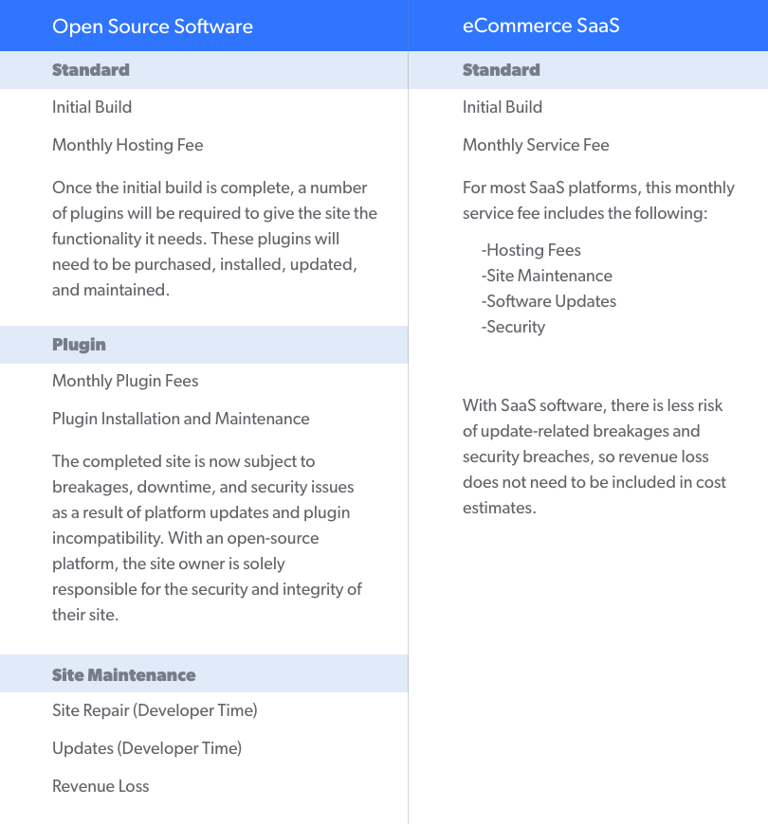By Miva | November 28, 2018

See why top ecommerce brands use Miva’s no-code platform to run
multiple stores, manage massive catalogs, and grow their revenue.
When you set out to build a new online store, you’ll be faced with a lot of decisions. Before you get caught up with choices regarding text, images, and colors, you’ll face a primary dilemma: do you want to build your ecommerce store with open source software or use a SaaS platform? For most merchants, cost is a primary consideration. But if you assume that an open source ecommerce platform will be cheaper, be sure to include all of the financial factors—not just for the launch year, but in the subsequent years as your store grows. This article will show you what to look for as you compare open source ecommerce platforms vs. SaaS ecommerce platforms.

Open source ecommerce software refers to ecommerce programs whose source code is made available to, used, and modified by users and developers. The open source community is highly collaborative and the basic code is usually released for free.
Developers in the community write plugins to add specific functionality to meet specific needs. Sometimes the plugins are free, but there is often a one-time, monthly, or annual charge. An open source ecommerce platform has some alluring benefits when it comes to launch pricing. There aren’t any recurring fees for the platform itself and the large developer community means it’s usually not too difficult to find individuals and agencies to work on it. Open source creates a platform that is highly extensible, giving the ability to expand as transaction volume grows.
Pros: Open source software promises limitless site potential for a one-time purchase. This can be tempting for merchants who don’t want to be boxed in by traditional SaaS software. When all is going right with open source ecommerce software, it can seem the obvious best choice.
Cons: Unfortunately, when things go wrong with open source, they can go very wrong. Plugins top the list of potential problems. Written by different coders, they’re often incompatible with each other. When plugins are outdated and unsupported they need to be replaced. As technology advances and your store’s needs change, an open source ecommerce platform will need external resources to make small changes and custom enhancements. This includes labor-intensive, expensive work to identify new plugins, creating and working in a development environment, troubleshooting errors, and installing upgrade packages. This will also involve juggling multiple scattered relationships, such as the provider of open-source software, your ecommerce agency, and the hosting company. Be sure to consider who is going to manage the team overseeing an open source site on an ongoing basis.
Successful businesses that make open source work often invest in workarounds. This can include hiring agencies to handle site design and maintenance. To mitigate against outages, they may pay extra for fast and reliable hosting with service level agreements (SLAs). They also often commission custom solution builds to avoid dependence on plugins.
SaaS stands for “Software as a Service” and describes software that is hosted and maintained by a third-party vendor. This software does not require downloading and can be accessed via web browser. A SaaS ecommerce platform is characterized by the following:
Pros: A traditional SaaS model offers the stability and security that open source platforms lack. Many merchants are drawn to the ease and reliability of SaaS ecommerce software, which typically requires far less development and maintenance than its open source counterparts.
Cons: Traditional SaaS models can be difficult to scale, putting frustrating limits on a store’s success. Sellers with complex products and large, high SKU-count catalogs can find it difficult to sell with traditional SaaS, as the functionality is often too lightweight to handle tens of thousands of product variations and order customization options.
To build a model budget for your ecommerce site, first begin with the initial site build, then include estimates for hosting, third party support for ongoing enhancements plus security, fixes, and maintenance. For open source estimates, you’ll need to budget for the cost of the plugins that add the essential functionality missing in the basic open source code.
While open source may seem like a cost-effective alternative to SaaS because it requires a one-time purchase fee rather than an ongoing monthly cost, the various hidden fees, repair costs, and lost revenue add up quickly. Make sure you know the potential total before making your final decision.

Headless ecommerce refers to an ecommerce solution that separates the front end (the customer-facing side of the website or the “head”) and the back end (the internal side where sellers manage orders and handle all logistics). The two systems, front end and back end, communicate via a set of API calls. In essence, merchants still use the back end for operational activities like managing orders and processing data while leveraging different front end software to build their online experience.
A separated front-end system can offer merchants extensive control over the customer-facing side of their website. Developers can leverage a modern JavaScript stack to build a unique web experience instead of relying on templates and making changes to the back end infrastructure. This option could be worth considering for businesses that want to push the envelope of innovation on their website and create entirely unique online experiences.
When fully leveraged, headless ecommerce can provide flexibility and website customization, however the capabilities required to keep the front and back ends separate often come with hidden costs and overhead. A decentralized system requires significant investment and a full expert development team to maintain the two ends. Headless options often lack native functionality, meaning merchants will need to invest in a variety of APIs and apps to create their ideal site. This leads to potentially unwieldy, costly, and plugin-heavy systems that mirror the dangers of open source and the limitations of traditional SaaS. Because of this, merchants should carefully consider the pros and cons when deciding if headless is right for their business.
Miva adopted a “limitless SaaS” model after seeing that customers needed a functional ecommerce solution without the massive overhead of headless and a more evolved platform to fill in the gap between open source and traditional SaaS. For many ecommerce merchants, open source offers lots of possibility but very little in the way of reliability, while traditional SaaS platforms can be far too restrictive for growing businesses. Miva provides professional oversight and streamlined site management, offering customers the use of optional in-house design and development teams. With fully scalable functionality and 24/7/365 support, this unique SaaS model combines the best of open source and SaaS to keep sites live, growing, and successful.
The needs of every ecommerce business are unique. To determine what the best fit is for your business, begin by calculating the potential cost of open source, and then compare it to the costs of SaaS ecommerce platforms. Define your store’s objectives and see how they compare to the functionality offered and the oversight needed with each solution. That will help you identify the provider that best meets your needs. 
Want to know more? Check out our webinar, The True Cost of Open Source.
Share this article:
No worries, download the PDF version now and enjoy your reading later...
Download PDF Miva
Miva
Miva offers a flexible and adaptable ecommerce platform that evolves with businesses and allows them to drive sales, maximize average order value, cut overhead costs, and increase revenue. Miva has been helping businesses realize their ecommerce potential for over 20 years and empowering retail, wholesale, and direct-to-consumer sellers across all industries to transform their business through ecommerce.
Visit Website